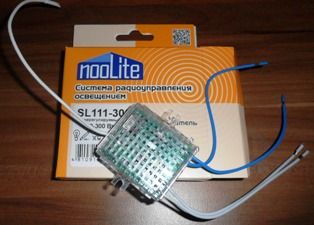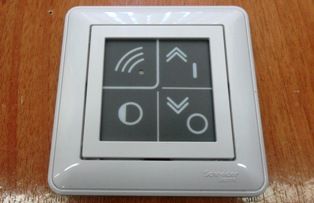Categories: Home automation, Electrical Reviews
Number of views: 26155
Comments on the article: 3
NooLite Lighting Control System: Making Your Home Smart
The article discusses the capabilities of NooLite electronic devices for controlling home lighting.
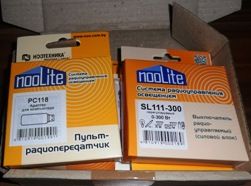 Reading about Bill Gates’s mansion worth $ 53 million, equipped with the ultra-modern “smart home” system, you involuntarily grumble: if we had his money, if the house were even “smarter”. And if you think about it, then our home is gradually acquiring elements of intelligence.
Reading about Bill Gates’s mansion worth $ 53 million, equipped with the ultra-modern “smart home” system, you involuntarily grumble: if we had his money, if the house were even “smarter”. And if you think about it, then our home is gradually acquiring elements of intelligence.
It’s rare that anyone controls a TV manually today - there is a remote control that takes care of all the setup tasks. Keychain motorists habitually lock cars. Modern refrigerators with programming operating modes, washing machines with dozens of washing programs - electronics imperceptibly, but surely enters into our everyday life.
And only lighting until recently has been deprived of attention. The emergence of a series of devices that allow you to remotely control the lighting of apartments by transmitting commands over the air, marked the end of the era of archaic keyboard switches.
It's about company products Nootehnika from Belarus(NooLite Lighting Control System).
The Nootekhnika company, located in the city of Minsk, produces control devices operating at a frequency of 433.92 MHz. According to their characteristics, they fit into smart home technology and are designed to work with various electrical equipment:
-
lighting systems in rooms and on the street, consisting of a variety of sources;
-
remote fan motors;
-
thermal heaters.
The appearance on the market of products of this company caused a wide resonance: the products of Western companies are being knocked down by their prices, and from China by their quality. Therefore, a set of modules with flexible functionality, at a very affordable price and ease of installation, attracted the attention of potential consumers.
The idea of creating control systems for household appliances such as “smart home” is not new. So, for example, American manufacturers have taken the path of using power wiring to control devices. These are PowerLine architecture systems using devices similar to PLC modems for transmitting data through a power grid.
The need to encode and decode information signals using algorithms that are resistant to interference in the power network makes this approach convenient from the point of view of system deployment, but difficult and expensive in hardware and software.
There are other options for remote lighting control for wiring. With their help, you can easily build entry-level home automation systems (X10, UPB) But these systems also have disadvantages caused by the need to transmit control signals via power wiring (sensitivity to interference in the network, relatively low reaction rate and response speed, inoperability with a broken wiring).
The Nootehnika company went along a more progressive path with the idea of communication between modules over the air. Today it offers a range of standard kits consisting of a transmitter and receiver for various types of lamps. In addition, several types of control panels can be purchased separately, including a small-sized remote control. Power (executive) blocks are represented by modifications for different capacities and types of loads.
We note a very interesting feature of the modules: the “intelligent” capabilities of the transmitter and receiver are almost equivalent, due to which amazing flexibility is achieved in the construction of lighting control systems.
The application is not limited only to lighting - the variety of types of loads with which the devices can work allows you to control fans, powerful heaters and even an iron if someone wants to bring the process of "training" home appliances to absurdity.
Modules are functionally divided into control panels (transmitters), and executive power units (receivers). The consoles are connected to power units via a radio channel with a frequency of 433.9 MHz. Communication range of 50 meters in the absence of obstacles.
The control panels are autonomous: they can be mounted in any convenient place with Velcro, stationary on the wall, or carried with you, although this is inconvenient. A disk battery with a resource of about a year is installed inside the case.
For the entry-level construction of smart home control systems NooLite series of modules is the best option. Starting with the simplest option, which includes only one transmitter and receiver, you can, by testing the convenience and reliability of products, continue to expand the system, including all new, maybe even unusual household appliances.
NooLite Lighting Technology
The executive element of the system is a power unit with a radio receiver and antenna. Through the wires of the supply network, zero and phase are supplied to it. After converting the received voltage according to certain algorithms, it is redirected via two other wires to lighting lamps or electric motors.
The signal from the radio transmitters can be detected by the power unit receiver at a distance of up to 50 meters.
NooLite remote controls and units are available in an extended range and have a variety of features. This allows you to select them according to the required characteristics for each house individually.
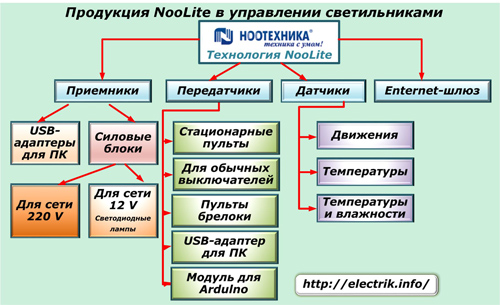
But, in order to simplify users' choice of suitable models, the manufacturer provides ready-made kits with standard solutions.
The minimum set of commands between the remote control and the unit is operations:
-
inclusion;
-
shutdowns;
-
brightness settings.
The prepared kits include solutions:
-
switch without wiring;
-
LED lamp dimming;
-
wireless motion sensor;
-
passage switch;
-
automatic fan control in the bathroom.
Features of NooLite Transmitters
The basis for the design of the remote control selected two technical solutions in the form:
-
a beautiful flat switch that can be fixed anywhere in the room with two dowels or a simplified method - with Velcro tapes;
-
a manual keyring as shown in the picture above.
On their front panel are membrane or touch buttons with an LED indicator that allows you to track the transfer of operating modes. The remote control is powered by a flat three-volt CR2032 battery (tablet). Practice has shown that its energy is enough for a year of operation.
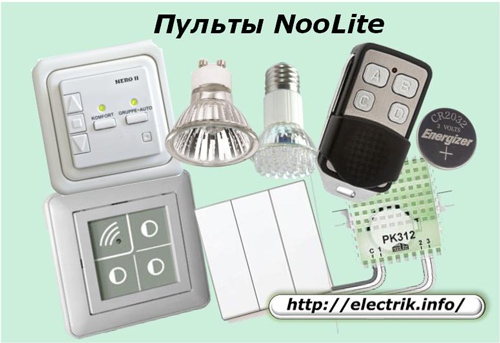
Remote controls can have from one to three control channels and the same combination of script channels. For LED models, the minimum set of control commands adds color selection functions and a smooth mode of color gamut with different time characteristics.
The script channel is intended for individual user settings, for example:
-
changing the light level of the chandelier for convenient viewing of television programs;
-
turning off lights in certain rooms or completely throughout the house.
To control the luminaire modes, the following symbols on the remote control are selected.
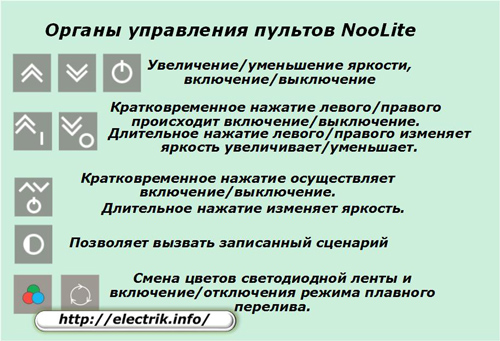
The choice of remote control is facilitated by the recommendations of Nootehnika.
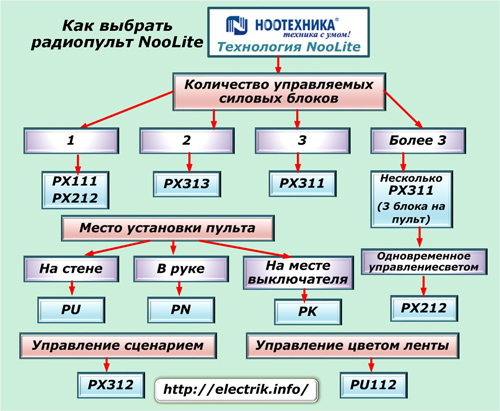
Features of NooLite Power Blocks
The rated power of the connected load, switched by Nootehnika blocks, ranges from 200 watts to 5 kW.
The dimensions of the models, designed for domestic purposes, allow you to embed them inside the protective cap of the chandelier or ceiling recess.
Power units are designed to work with light sources powered by a 220 volt or 12 volt network (LED lamps and ribbons).

They are marked with the letters SN, ST, SL.SN devices operate on a 220 network with incandescent, halogen, LED and LED strips.
The ST series is designed to control 12-volt halogen sources with the ability to adjust brightness, as with SN units. This function is not available for SL series units working with incandescent, halogen and fluorescent lamps.
In order to accurately select a power unit for lighting, Nootechnika offers an algorithm that has already been tested by users.

Features of NooLite sensors
The company's sensors operate over the air and do not require a wired network connection. They are convenient to install in any accessible place.
Motion Sensor PM111 controls the distance up to 5 meters, and transmits a signal to 50. It independently turns on the lighting when a person appears in the observation zone and turns it off when leaving, saving energy.
RT111 temperature and humidity sensor controls the temperature within -20 ÷ + 50 degrees, and humidity - 1 ÷ 99%. It can measure or control environmental parameters:
1. heaters in thermostat mode;
2. fans in the hygrostat program.
Moreover, the executive motors can be removed up to 50 meters.
Preparation of transmitters and power units for work
After purchasing a set of equipment, you will need to configure it for sharing, “bind” to each other. This is done when the power block is turned on under voltage and load. Performing such work on the ceiling is not convenient, and dangerous.
It is best to set up the equipment on the table using an extension cord with a socket and a table lamp. Pay attention to the quality of connection of the connected ends and their isolation: at the remote control and the unit, you will have to press the service buttons and follow the LEDs.
All information about the settings in detail with pictures is given in the operating instructions.
NooLite Adapters
Nootehnika's products are adapted to be controlled from one place using a computer or even a smartphone or mobile phone. For this, special software and USB adapters have been created:
-
based on PC118 radio transmitters (8 communication channels), PC1116 (16), PC1132 (32);
-
based on the RX2164 radio, which processes the signals coming from the consoles.
Remote access is provided by the PR1132 Ethernet Gateway.

When using it, a wide range of management capabilities is provided. PR1132 can be attributed from the power unit to 100 meters and integrate lighting into the Smart Home smart system. At the same time, it is convenient to view information from all sensors.
In addition to a smartphone, electronic novelties - “Smart Watches” of the Pebble series allow you to control the system.
NooLite devices are available with the ability to work together. To do this, you need to make certain user settings.
The price policy of Nootechnics for Smart Home systems ($ 600 ÷ 1200) is aimed at working in the CIS market and significantly wins when compared with similar offers from manufacturers from Gira, ABB, Jung ($ 3000 ÷ 5000).
An extended set of her developments for the apartment is selling for $ 600 ÷ 800.
See also at bgv.electricianexp.com
:

